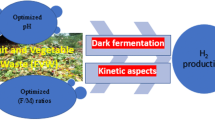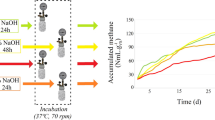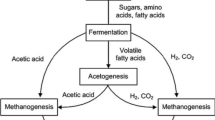Abstract
Purpose
The objective of this work was to optimize the anaerobic fermentation of a mixed waste stream, consisted of fruit and vegetables that have lost their marketing value and a disposable nappies’ hydrolysate. More specifically, the aim was to identify the optimal pH value for maximum hydrogen production and valuable metabolites such as volatile fatty acids and ethanol.
Methods
A wide range of pH values was tested (from 4.5 to 7.5 with 0.5 increment) using an automatic controller system, in batch fermentations that took place in mesophilic temperature conditions (37 °C). The first set of experiments was carried out with the fruit and vegetables mixture, diluted with water (2:3 v/v) and subsequent trials followed using the fruit and vegetable mixture with the disposable nappies’ hydrolysate at the same ratio (2:3 v/v).
Results
The maximum hydrogen volume was produced at pH 6.0 (1.34 L H2/LReactor) for the fruit/vegetable stream whereas, the maximum concentration of ethanol and volatile fatty acids (15.60 g/L) was reached at pH 6.5 for the same substrate. Regarding the mixed waste stream, both hydrogen production and metabolites concentration reached a maximum at pH 7.5 with 4.09 L H2/LReactor and 17.16 g/L respectively.
Conclusions
Different optimum pH value for bio-hydrogen production was observed between the anaerobic fermentation of the two substrates (fruit/vegetables waste and mixed waste stream). Higher overall yields and concentrations of the metabolic products were obtained with the fermentation of the mixed substrate.
Graphic Abstract






Similar content being viewed by others
References
Qi, N., Hu, X., Zhao, X., Li, L., Yang, J., Zhao, Y., Li, X.: Fermentative hydrogen production with peanut shell as supplementary substrate: effects of initial substrate, pH and inoculation proportion. Renew. Energy. 127, 559–564 (2018). https://doi.org/10.1016/j.renene.2018.05.018
Elbeshbishy, E., Dhar, B.R., Nakhla, G., Lee, H.S.: A critical review on inhibition of dark biohydrogen fermentation. Renew. Sustain. Energy Rev. 79, 656–668 (2017)
Yamin, J.A.A.: Comparative study using hydrogen and gasoline as fuels: combustion duration effect. Int. J. Energy Res. 30, 1175–1187 (2006). https://doi.org/10.1002/er.1213
Ghimire, A., Frunzo, L., Pirozzi, F., Trably, E., Escudie, R., Lens, P.N.L., Esposito, G.: A review on dark fermentative biohydrogen production from organic biomass: process parameters and use of by-products. Appl. Energy 15, 73–95 (2015)
Yun, Y.-M., Lee, M.-K., Im, S.-W., Marone, A., Trably, E., Shin, S.-R., Kim, M.-G., Cho, S.-K., Kim, D.-H.: Biohydrogen production from food waste: current status, limitations, and future perspectives. Bioresour. Technol. 248, 79–87 (2018). https://doi.org/10.1016/J.BIORTECH.2017.06.107
Braguglia, C.M., Gallipoli, A., Gianico, A., Pagliaccia, P.: Anaerobic bioconversion of food waste into energy: a critical review. Bioresour. Technol. 248, 37–56 (2018)
Tawfik, A., El-Qelish, M.: Continuous hydrogen production from co-digestion of municipal food waste and kitchen wastewater in mesophilic anaerobic baffled reactor. Bioresour. Technol. 114, 270–274 (2012). https://doi.org/10.1016/j.biortech.2012.02.016
Ren, N.Q., Cao, G.L., Guo, W.Q., Wang, A.J., Zhu, Y.H., Liu, B.F., Xu, J.F.: Biological hydrogen production from corn stover by moderately thermophile thermoanaerobacterium thermosaccharolyticum W16. Int. J. Hydrogen Energy. 35, 2708–2712 (2010). https://doi.org/10.1016/j.ijhydene.2009.04.044
Dareioti, M.A., Vavouraki, A.I., Kornaros, M.: Effect of pH on the anaerobic acidogenesis of agroindustrial wastewaters for maximization of bio-hydrogen production: a lab-scale evaluation using batch tests. Bioresour. Technol. 162, 218–227 (2014). https://doi.org/10.1016/j.biortech.2014.03.149
Castelló, E., Braga, L., Fuentes, L., Etchebehere, C.: Possible causes for the instability in the H2 production from cheese whey in a CSTR. Int. J. Hydrogen Energy. 43, 2654–2665 (2018). https://doi.org/10.1016/j.ijhydene.2017.12.104
Yeshanew, M.M., Frunzo, L., Pirozzi, F., Lens, P.N.L., Esposito, G.: Production of biohythane from food waste via an integrated system of continuously stirred tank and anaerobic fixed bed reactors. Bioresour. Technol. 220, 312–322 (2016). https://doi.org/10.1016/j.biortech.2016.08.078
Sotelo-Navarro, P.X., Poggi-Varaldo, H.M., Turpin-Marion, S.J., Vázquez-Morillas, A., Beltrán-Villavicencio, M., Espinosa-Valdemar, R.M.: Biohydrogen production from used diapers: evaluation of effect of temperature and substrate conditioning. Waste Manag. Res. 35, 267–275 (2017). https://doi.org/10.1177/0734242X16677334
EDANA: Sustanability report. ISBN 2–930159–7, D/2011/5705/1 (2015). https://www.sustainability.edana.org/Objects/10/Files/sustainabilityReport.2015.pdf
Colón, J., Ruggieri, L., Sánchez, A., González, A., Puig, I.: Possibilities of composting disposable diapers with municipal solid wastes. Waste Manag. Res. 29, 249–259 (2011). https://doi.org/10.1177/0734242X10364684
Colón, J., Mestre-Montserrat, M., Puig-Ventosa, I., Sánchez, A.: Performance of compostable baby used diapers in the composting process with the organic fraction of municipal solid waste. Waste Manag. 33, 1097–1103 (2013). https://doi.org/10.1016/j.wasman.2013.01.018
Arena, U., Ardolino, F., Di Gregorio, F.: Technological, environmental and social aspects of a recycling process of post-consumer absorbent hygiene products. J. Clean. Prod. 127, 289–301 (2016). https://doi.org/10.1016/j.jclepro.2016.03.164
Cox, J.-A., Druckman, A., Jesson, D., Mulheron, M., Smyth, M., Trew, H.: Municipal solid waste as a resource: part 2—case study in sustainable management. Proc. Inst. Civ. Eng. Waste Resour. Manag. 168, 115–130 (2015). https://doi.org/10.1680/warm.14.00012.
Durmusoglu, E., Taspinar, F., Karademir, A.: Health risk assessment of BTEX emissions in the landfill environment. J. Hazard. Mater. 176, 870–877 (2010). https://doi.org/10.1016/j.jhazmat.2009.11.117
Edwards, J., Othman, M., Crossin, E., Burn, S.: Life cycle assessment to compare the environmental impact of seven contemporary food waste management systems. Bioresour. Technol. 248, 156–173 (2018). https://doi.org/10.1016/j.biortech.2017.06.070
Mohd Yasin, N.H., Rahman, N.A., Man, H.C., Mohd Yusoff, M.Z., Hassan, M.A.: Microbial characterization of hydrogen-producing bacteria in fermented food waste at different pH values. Int. J. Hydrogen Energy. 36, 9571–9580 (2011). https://doi.org/10.1016/j.ijhydene.2011.05.048
Khan, M.A., Ngo, H.H., Guo, W.S., Liu, Y., Nghiem, L.D., Hai, F.I., Deng, L.J., Wang, J., Wu, Y.: Optimization of process parameters for production of volatile fatty acid, biohydrogen and methane from anaerobic digestion. Bioresour. Technol. 219, 738–748 (2016). https://doi.org/10.1016/j.biortech.2016.08.073
Wang, J., Wan, W.: Factors influencing fermentative hydrogen production: a review. Front. Niosci. 22, 1195–1220 (2009)
Conway, M.E., Jooste, F., Smith, M.D.: Treatment of absorbent sanitary paper products. J. Clean. Prod. US Patent (1997). https://doi.org/10.1016/S0959-6526(97)82420-1
APHA/AWWA/WEF: Standard methods for the examination of water and wastewater. Stand Methods 541. APHA/AWWA/WEF, Washington (2012)
Joseffson, B.: Rapid spectrophotometric determination of total carbohydrates. In: Grasshoff, K., Ehrhardt, M., Kremling, K. (eds.) Methods Seawater, pp. 340–342. Anal. Verlag Chemie GmbH, Weinheim (1983)
Waterman, P.G., Mole, S.: Analysis of Phenolic Plant Metabolites. Blackwell, Oxford (1994)
Kirchmann, H., Pettersson, S.: Human urine: Chemical composition and fertilizer use efficiency. Fertil. Res. 40, 149–154 (1994). https://doi.org/10.1007/BF00750100
Fisgativa, H., Tremier, A., Dabert, P.: Characterizing the variability of food waste quality: a need for efficient valorisation through anaerobic digestion. Waste Manag. 50, 264–274 (2016). https://doi.org/10.1016/j.wasman.2016.01.041
Nguyen, D., Gadhamshetty, V., Nitayavardhana, S., Khanal, S.K.: Automatic process control in anaerobic digestion technology: a critical review. Bioresour. Technol. 193, 513–522 (2015)
Ginkel, S.V., Sung, S., Lay, J.J.: Biohydrogen production as a function of pH and substrate concentration. Environ. Sci. Technol. 35, 4726–4730 (2001). https://doi.org/10.1021/es001979r
Chu, C.F., Li, Y.Y., Xu, K.Q., Ebie, Y., Inamori, Y., Kong, H.N.: A pH- and temperature-phased two-stage process for hydrogen and methane production from food waste. Int. J. Hydrogen Energy 33, 4739–4746 (2008). https://doi.org/10.1016/j.ijhydene.2008.06.060
Wang, K., Yin, J., Shen, D., Li, N.: Anaerobic digestion of food waste for volatile fatty acids (VFAs) production with different types of inoculum: effect of pH. Bioresour. Technol. 161, 395–401 (2014). https://doi.org/10.1016/j.biortech.2014.03.088
Wu, Y., Ma, H., Zheng, M., Wang, K.: Lactic acid production from acidogenic fermentation of fruit and vegetable wastes. Bioresour. Technol. 191, 53–58 (2015). https://doi.org/10.1016/j.biortech.2015.04.100
Ren, N., Wang, B., Huang, J.C.: Ethanol-type fermentation from carbohydrate in high rate acidogenic reactor. Biotechnol. Bioeng. 54, 428–433 (1997)
Zhang, Y.-J., Jiang, J.-G., Wang, J.-M.: Effect of pH value on VFA concentration and composition during anaerobic fermentation of kitchen waste. China Environ. Sci. 33, 680–684 (2013)
Thauer, R.K., Jungermann, K., Decker, K.: Energy conservation in chemotrophic anaerobic bacteria. Bacteriol. Rev. 41, 100–180 (1977)
Stavropoulos, K.P., Kopsahelis, A., Zafiri, C., Kornaros, M.: Effect of pH on continuous biohydrogen production from end-of-life dairy products (EoL-DPs) via dark fermentation. Waste Biomass. Valoriz. 7, 753–764 (2016). https://doi.org/10.1007/s12649-016-9548-7
Khanal, S.K., Chen, W.H., Li, L., Sung, S.: Biological hydrogen production: effects of pH and intermediate products. Int. J. Hydrogen Energy. 29, 1123–1131 (2004). https://doi.org/10.1016/j.ijhydene.2003.11.002
Papoutsakis, E.T.: Equations and calculations for fermentations of butyric acid bacteria. Biotechnol. Bioeng. 67, 813–826 (2000)
Lee, C., Lee, S., Han, S.-K., Hwang, S.: Effect of operational pH on biohydrogen production from food waste using anaerobic batch reactors. Water Sci. Technol. 69, 1886–1893 (2014). https://doi.org/10.2166/wst.2014.097
Suo, Y., Fu, H., Ren, M., Yang, X., Liao, Z., Wang, J.: Butyric acid production from lignocellulosic biomass hydrolysates by engineered Clostridium tyrobutyricum overexpressing Class I heat shock protein GroESL. Bioresour. Technol. 250, 691–698 (2018). https://doi.org/10.1016/j.biortech.2017.11.059
Shi, E., Li, J., Zhang, M.: Application of IWA anaerobic digestion model no. 1 to simulate butyric acid, propionic acid, mixed acid, and ethanol type fermentative systems using a variable acidogenic stoichiometric approach. Water Res. 161, 242–250 (2019). https://doi.org/10.1016/j.watres.2019.05.094
Fang, H.H.P., Liu, H.: Effect of pH on hydrogen production from glucose by a mixed culture. Bioresour. Technol. 82, 87–93 (2002). https://doi.org/10.1016/S0960-8524(01)00110-9
Jiang, J., Zhang, Y., Li, K., Wang, Q., Gong, C., Li, M.: Volatile fatty acids production from food waste: effects of pH, temperature, and organic loading rate. Bioresour. Technol. 143, 525–530 (2013). https://doi.org/10.1016/j.biortech.2013.06.025
Zhou, M., Yan, B., Wong, J.W.C., Zhang, Y.: Enhanced volatile fatty acids production from anaerobic fermentation of food waste: a mini-review focusing on acidogenic metabolic pathways. Bioresour. Technol. 248, 68–78 (2018)
Ren, N., Xing, D., Rittmann, B.E., Zhao, L., Xie, T., Zhao, X.: Microbial community structure of ethanol type fermentation in bio-hydrogen production. Environ. Microbiol. 9, 1112–1125 (2007). https://doi.org/10.1111/j.1462-2920.2006.01234.x
Sivagurunathan, P., Sen, B., Lin, C.Y.: Overcoming propionic acid inhibition of hydrogen fermentation by temperature shift strategy. Int. J. Hydrogen Energy 39, 19232–19241 (2014)
Acknowledgements
The authors gratefully acknowledge the financial support of this study by the European Commission - Executive Agency for Small and Medium-sized Enterprises (EASME) - Project WASTE4THINK (H2020 - GA 688995) “Moving towards Life Cycle Thinking by integrating Advanced Waste Management Systems”.
Author information
Authors and Affiliations
Corresponding author
Ethics declarations
Conflict of interest
The authors declare that they have no conflict of interest.
Additional information
Publisher's Note
Springer Nature remains neutral with regard to jurisdictional claims in published maps and institutional affiliations.
Rights and permissions
About this article
Cite this article
Tsigkou, K., Tsafrakidou, P., Athanasopoulou, S. et al. Effect of pH on the Anaerobic Fermentation of Fruit/Vegetables and Disposable Nappies Hydrolysate for Bio-hydrogen Production. Waste Biomass Valor 11, 539–551 (2020). https://doi.org/10.1007/s12649-019-00854-z
Received:
Accepted:
Published:
Issue Date:
DOI: https://doi.org/10.1007/s12649-019-00854-z




